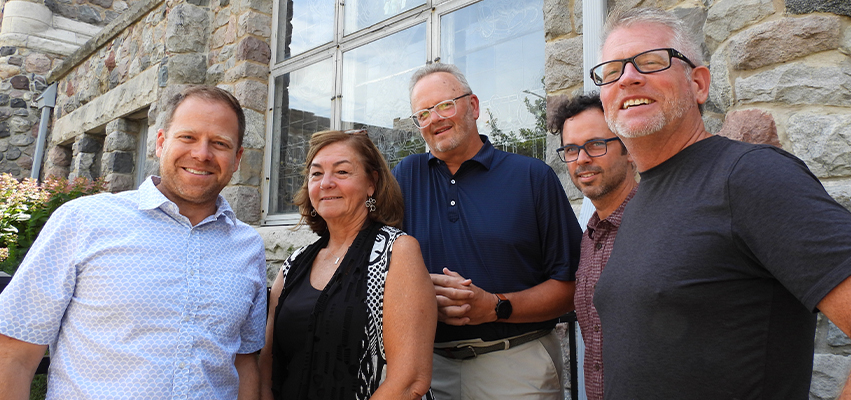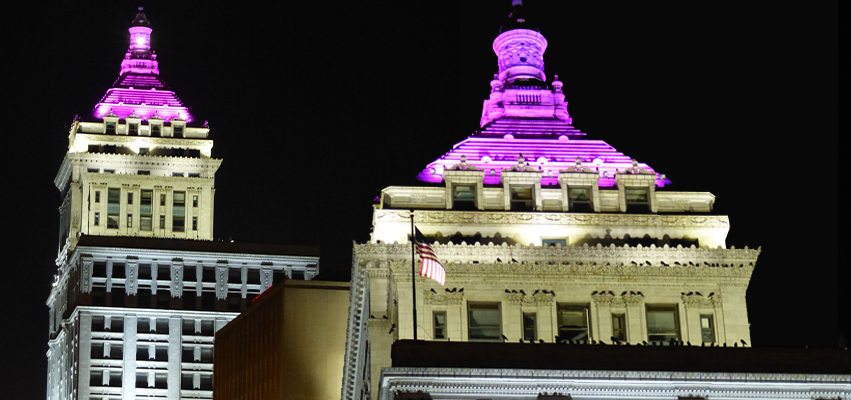The verdict is in: If Peoria had a golden age of architecture and grand ambition, it was well more than a century ago.
Recently Peoria Magazine asked five local architects to choose their personal top 10 of architecturally significant buildings in Illinois.

That all-star cast/jury — Debbie Baker of Architectural Design Group; Paul Kouri of Farnsworth Group; Anthony Corso, an urban design and planning consultant and former chief innovation officer for the city of Peoria; Wil Helmick of PCM+Design Architects; and the guy who put this team together, Mark Misselhorn, chairman of the Downtown Advisory Commission following a long career at apaceDesign and Core Construction Services – ultimately forwarded 45 structures for consideration.
‘We don’t build buildings to last 100 years anymore’
— Wil Helmick
The votes were totaled and the clear frontrunner was the Peoria Civic Center, which opened in 1982 — my how time flies — with its “necklace” of glass that so complemented the historic and architecturally elaborate City Hall next door in what became something of the “mega-block” Downtown.
The Philip Johnson-envisioned Civic Center – by then Johnson already had been named the first winner of the prestigious Pritzker Architecture Prize — was followed by 416 Main (originally the Peoria Life Insurance building, later First National Bank, then Commerce Bank), Madison Theatre, Bradley University’s Westlake Hall, and OSF HealthCare Mission Headquarters (formerly the Block & Kuhl building).
Rounding out the list were Peoria City Hall, Obed & Isaac’s Microbrewery (originally the 2nd Presbyterian Church), the Frances W. Little House on Moss Avenue, the Rock Island Depot/River Station and St. Mary’s Cathedral. Honorable mentions went to St. Paul’s Episcopal Church and the Motherhouse.
All but the Motherhouse, the novitiate for the Sisters of the Third Order of St. Francis outside Germantown Hills, are in the city of Peoria. The youngest building clocked in at 40, the oldest at 133, with an average age of 111 years.
“We don’t build buildings to last 100 years anymore,” said Helmick.
“That’s what’s sad,” said Baker.
“Our priorities are different,” said Corso.
There is a sense of something having been lost along the way
This kind of exercise is a subjective one, of course – an eye-of-the-beholder thing — so this is by no means the definitive list. It represents the opinions of five professionals in the field. Others may have different points of view. Even with this group, there was some second-guessing upon reflection. Certainly, central Illinois has its share of modern, attractive structures.
But there are a lot of relatively unadorned, cookie-cutter boxes and rectangles being constructed in central Illinois, too, and there certainly is a sense in some quarters of something having been lost along the way from the days when Peoria not only bragged an array of accomplished homegrown architects spreading their creative wings but attracted the likes of Frank Lloyd Wright, W.W. Boyington (Chicago’s Water Tower), Henry Ives Cobb and Philip Johnson to town.
The group recently convened for lunch at one of the chosen – Obed & Isaac’s, 321 NE Madison in Peoria, which began as a place of worship, as so many grand structures do – to talk about what went right on the central Illinois architecture/community building scene for so long and, of late, what has changed.
First, they had to settle on what “significant” means in the context of architecture.
As Corso put it, “It can be your trusty friend. It doesn’t have to be the most beautiful building.” For many, “just think about Peoria without it” became the litmus test for their selections. Case in point is the Civic Center. Leaders from that time have noted that if there had been a public referendum on its construction, it likely would have failed. Philip Johnson himself reportedly was not happy with the finished product after budget cuts were made. Sometimes, it takes a while for a place to grow on a community.
Second, they don’t view Peoria as an aberration, architecturally speaking, certainly among cities its size.
“I feel like we’re average,” said Misselhorn. “A lot of it is economically driven.” Meanwhile, the nation collectively seems to have turned inward, more focused on the “me” rather than the “we,” opined Corso, turning statement-making projects, public and private, into rarer gestures, especially outside of major metropolises. Function often trumps form.
Still, there was some picker’s regret here. The Downtown museum block, now 10 years old, got some on-second-thought love from this group. Some cited the likewise youthful General Wayne A. Downing Peoria International Airport terminal as an overlooked gem, as well.
Meanwhile, “if things had gone as planned four or five years ago, we might be including the Cat world headquarters,” said Misselhorn. “It might have been a game-changer, done with an appropriate budget by a world-class design firm. Maybe that would be on our list.”
That doesn’t let Peoria completely off the hook.
At some point, urban planners decided to accommodate vehicles at the expense of pedestrians, which may have been taken to extreme in some parts of central Illinois. Sprawl and vast parking lots dominated, at great expense to local taxpayers. There were even efforts to “suburbanize” downtowns, to ultimately regrettable effect in many communities. In Peoria, “we built roadways for a city of 450,000,” instead of the city of 112,000 that Peoria actually is, said Corso.
Meanwhile, there’s the “self-esteem” issue, said Misselhorn, the feeling that “we can’t have nice things,” that it’s something other communities do. Often it takes visitors to remind the locals what we have here — the stunning scenery of the Illinois River valley, Peoria’s rich and often unrecognized history, so many “wow” buildings and homes at affordable prices.
Of course, architects also tend to deliver what their clients want, and often higher-level architecture is not on the radar. “Get it built faster and for less money” is the common expectation, said Misselhorn.
It wasn’t always so. At the turn of the 20th century, Peoria industrialists built palaces to live in. Those who came here to make their fortunes, not uncommonly immigrants with wider experiences and perspectives, demanded the same of their public spaces — their government buildings, schools, churches, places of commerce, etc. Even for people of more modest means, there was a value placed on craftsmanship and on the artisans who delivered it.
In the 1960s and ‘70s, under an activist City Council and business community, the Demetrious Plan reimagined Peoria’s Downtown, with the Civic Center being one result.
“Look at the investment that went into 416 (Main) when it was built,” or into the old Block & Kuhl building that now houses OSF, said Baker. “It was the closest we had to walking into Marshall Field.
“They were making a statement.”
Meanwhile, buildings constructed to last do last, retaining their value even as their uses evolve. The “stunning” OSF HealthCare Mission Headquarters, once perilously close to demolition, may be the best example.
It’s harder today. Sometimes there is a lack of consensus, with ongoing tension between the desires of the existing power structure and those at the grass roots, with fewer mobilizing forces behind the decision-making. The communication can fall short.
What will it take to get our groove back?
“It’s multifaceted,” said Corso. “There has to be leadership and there has to be vision and you have to bring people together to let them know why it’s important … It’s a slow-moving process, to get everybody on board.”
Why does any of it matter?
“If you don’t have place affinity, if you don’t love where you live, you don’t fight for it,” which can have other unwelcome ramifications, said Corso.
“When it’s done well, people love it, they keep coming back,” said Kouri.
“When it’s not, they avoid it,” which has consequences for everyone from residents wanting to keep a lid on their tax bills to employers seeking skilled workers.
People want “an emotional attachment,” said Misselhorn. “I do think the built environment – the streets and the buildings and how they come together
… and the communities they create
— that’s what makes that.”
‘If you don’t love where you live, you don’t fight for it’
— Anthony Corso
“It can be modern or it can be 150 years old, if it’s the right experience and the right scale and it’s walkable …,” said Corso.
It may be a subconscious thing, but at the end of the day, that environment “makes people feel good,” said Baker.
Let the discussions begin.
The Peoria Area’s Architectural Top 10
- Peoria Civic Center – Completed 1982, architects Johnson Burgee (New York), style Post-Modern
- 416 Main, Peoria (formerly Peoria Life Insurance, First National Bank, Commerce Bank) – Completed 1924, architects Hewitt & Emerson (Peoria), Chicago Style, Beaux-Arts
- Madison Theatre, Peoria (all the grand theaters of yore) – Completed 1920, architect Frederick Klein (Peoria), ornate Italian Renaissance
- Westlake Hall, Bradley University, Peoria – Completed 1897, renovated and expanded 2012, architect Henry Ives Cobb (Chicago), PSA Dewberry (Peoria), Collegiate Gothic
- OSF HealthCare Mission Headquarters, Peoria (formerly Schipper & Block, Block & Kuhl, Jefferson Bank, etc.) – Completed 1905, original architect unknown, renovation by PSA Dewberry (Peoria), Chicago Style, Beaux-Arts
- Peoria City Hall – Completed 1897, architects Reeves & Baillee (Peoria), Flemish Renaissance
- Obed & Isaac’s, Peoria (formerly 2nd Presbyterian Church, Donmeyer Temple, etc.) – Completed 1889, architect W.W. Boyington (Chicago), Richardsonian Romanesque Revival
- Frances W. Little House, 1505 W. Moss Ave., Peoria – Completed 1903, architect Frank Lloyd Wright (Chicago), Prairie Style
- Rock Island Depot/River Station, Peoria – Completed 1900, architect unknown, Neo-Renaissance, Classical Revival, Italian Villa
- St. Mary’s Cathedral, Peoria – Completed 1889, architect Casper Mehler (Chicago), renovation Daprato Rigali Studios (Chicago), Neo-Gothic
Honorable mention:
- St. Paul’s Episcopal Church, Peoria – Completed 1959, architect Frederick Dunn (St. Louis), Mid-Century Modern
- Motherhouse, East Peoria/rural Germantown Hills – Completed 1967, architect Cletis Roy Foley (Peoria), Mid-Century Modern





